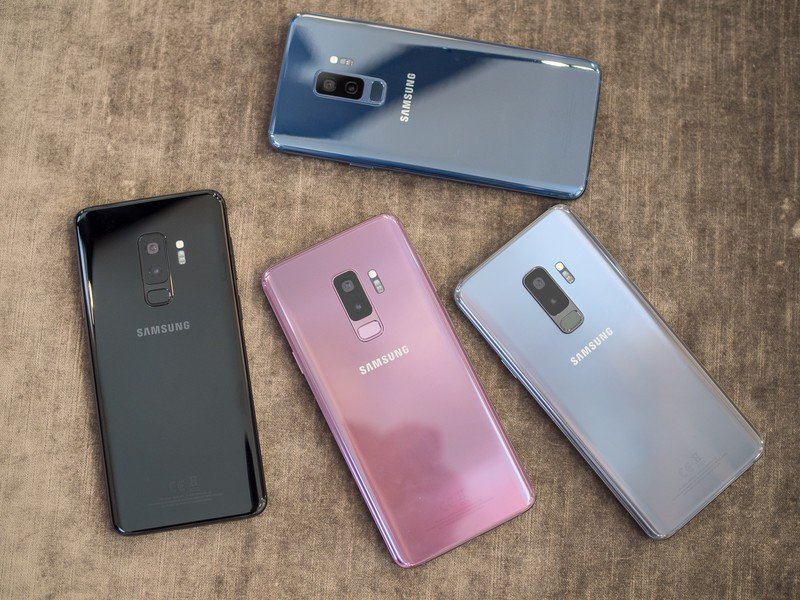Samsung Galaxy S9+ tested: Exynos 9810 vs. Snapdragon 845

From the Galaxy S7 onward, Samsung has offered two variants of its flagships — a model powered by Qualcomm's Snapdragon platform for the U.S. and China, and a global variant featuring the manufacturer's in-house Exynos chipset. That's the case this year as well: the Galaxy S9 and S9+ sold in the U.S. and China are powered by Qualcomm's latest Snapdragon 845, while the models sold in South Korea, UK, India, and other global markets are running the Exynos 9810.
Traditionally, there haven't been a lot of differences between the two variants — the Exynos 8895-powered Galaxy S8+ had marginally better battery life over its Snapdragon sibling, but there wasn't a performance differential. With my unit powered by the Exynos 9810, and my colleague Andrew Martonik using the Snapdragon variant, it's time to see how the two variants differ.
Hardware

There isn't a whole lot to separate the Exynos 9810 from the Snapdragon 845 when it comes to the manufacturing side of things, as both chipsets are built on Samsung Foundry's second-gen 10nm node. The Exynos 9810 features Samsung's third-generation custom core, the M3, along with a Mali-G72 MP18 GPU. The Snapdragon 845, meanwhile, sees the introduction of the Kryo 385 cores, along with the Adreno 630 GPU.
As is to be expected, both chipsets offer increased performance, with Samsung touting a 2x increase in single-core performance compared to last year's Exynos 8895, as well as a 40% uptick in multi-core performance. That's largely due to the M3 cores, which are now clocked at 2.90GHz, a significant bump from the 2.3GHz M2 cores last year. The configuration of the cores itself hasn't changed — there are four M3 high-performance cores that go up to 2.90GHz, backed by four energy-efficient Cortex A55 cores at 1.90GHz.
The Exynos 9810 nearly doubles CPU performance from last year.
The second set of cores are also significant, as they're the long-awaited sequel to the Cortex A53. The A53 has been a mainstay on budget phones and flagships alike for a few years now, and the A55 delivers more performance while consuming less power.
The uptick isn't as radical when it comes to the GPU side of things. Like its predecessor, the Mali-G72 MP18 is based on ARM's Bifrost architecture, and introduces several tweaks and optimizations to eke out more performance. This year's GPU has 18 cores (hence the MP18 denomination) whereas the one seen in the Galaxy S8+ last year, the Mali-G71 MP20, had 20 cores. The core frequency hasn't seen a drastic uptick either — the G72 is clocked at 572MHz, just 30MHz more than the G71. As a result, the overall graphics performance is marginally better than last year.
With the Snapdragon 845, Qualcomm is also sticking to an octa-core layout, with four high-performance cores joined by four energy-efficient cores. This year we have the Kryo 385 core, which is a semi-custom design that's based on two of ARM's cores.
Be an expert in 5 minutes
Get the latest news from Android Central, your trusted companion in the world of Android
The heavy lifting is done by the 2.80GHz core based on the Cortex A75 — ARM's latest offering — and the energy-efficient tasks are handled by a 1.77GHz core based on the Cortex A55. As for the GPU, Qualcomm is touting a 30% uptick in performance from the Adreno 630 over last year's Adreno 540.
Benchmarks
Synthetic benchmarks give us a high-level overview of where the two chipsets differ. Based on the hardware, the Exynos 9810's M3 CPU should outperform the Snapdragon 845, whereas the Adreno 630 should have no issues pulling out ahead of the Mali-G72. Let's see if that's indeed the case. I've also included scores from the Exynos 8895-powered Galaxy S9+ to see how things have changed over the course of a year.
AnTuTu
AnTuTu Benchmark v7.0.4
| Device | Overall score |
|---|---|
| Galaxy S9+ (Snapdragon 845) | 263494 |
| Galaxy S9+ (Exynos 9810) | 235913 |
| Galaxy S8+ (Exynos 8895) | 184806 |
AnTuTu Benchmark v7.0.4
| Device | CPU | GPU | UX | Memory |
|---|---|---|---|---|
| Galaxy S9+ (Snapdragon 845) | 88377 | 107305 | 58657 | 9155 |
| Galaxy S9+ (Exynos 9810) | 81915 | 94881 | 50681 | 8436 |
| Galaxy S8+ (Exynos 8895) | 58957 | 77255 | 44139 | 4455 |
AnTuTu isn't a reliable indicator of how good a device is to use on a day-to-day basis, but it maintains a leaderboard that gives us an idea of where a particular phone ranks in the overall scheme of things.
As you can make out from the scores above, the Adreno 630 is some way ahead of the Mali G72, breaking the 100,000 mark on AnTuTu.
Geekbench
Geekbench 4.0
| Device | Single-core | Multi-core |
|---|---|---|
| Galaxy S9+ (Snapdragon 845) | 2443 | 8359 |
| Galaxy S9+ (Exynos 9810) | 3668 | 9006 |
| Galaxy S8+ (Exynos 8895) | 1956 | 6624 |
Geekbench 4.0 includes CPU tests that are modeled after real-world usage, allowing you to get an overview of how a processor handles day-to-day tasks, including multi-core performance.
Here that we get to see the Exynos 9810 pull ahead of the Snapdragon 845, both in single-core and multi-core performance.
Basemark
Basemark OS II
| Device | Overall | System | Memory | Graphics | Web |
|---|---|---|---|---|---|
| Galaxy S9+ (Snapdragon 845) | 4145 | 7791 | 3561 | 7958 | 1337 |
| Galaxy S9+ (Exynos 9810) | 3165 | 6042 | 2388 | 6371 | 1097 |
| Galaxy S8+ (Exynos 8895) | 3045 | 4934 | 2474 | 6219 | 1135 |
Basemark OS II is a system-level benchmarking tool that gives a high-level overview of a device's performance. The suite consists of an array of tests that gauge the system, internal and external memory, graphics, and web browsing performance.
Basemark Web 3.0
| Device | Score |
|---|---|
| Galaxy S9+ (Snapdragon 845) | 322.11 |
| Galaxy S9+ (Exynos 9810) | 216.80 |
| Galaxy S8+ (Exynos 8895) | 198.96 |
Basemark Web 3.0 offers a set of over 20 web benchmarks that measure browser performance and graphics, including page load responsiveness, along with CSS, and HTML5 capabilities.
GFXBench
GFXBench 4.0 Manhattan 3.1 (ES3.1)
| Device | FPS |
|---|---|
| Galaxy S9+ (Snapdragon 845) | 32 |
| Galaxy S9+ (Exynos 9810) | 24 |
| Galaxy S8+ (Exynos 8895) | 23 |
GFXBench 4.0 1080p Car Chase Offscreen (ES3.1)
| Device | FPS |
|---|---|
| Galaxy S9+ (Snapdragon 845) | 35 |
| Galaxy S9+ (Exynos 9810) | 28 |
| Galaxy S8+ (Exynos 8895) | 25 |
GFXBench 4.0 T-Rex (ES2.0)
| Device | FPS |
|---|---|
| Galaxy S9+ (Snapdragon 845) | 60 |
| Galaxy S9+ (Exynos 9810) | 60 |
| Galaxy S8+ (Exynos 8895) | 58 |
GFXBench tests the graphics performance of a device, and we see the Adreno 630 once again edging out the Mali G72.
3DMark
3DMark Sling Shot Extreme (ES3.1)
| Device | Overall | Graphics | Physics |
|---|---|---|---|
| Galaxy S9+ (Snapdragon 845) | 4587 | 5078 | 3428 |
| Galaxy S9+ (Exynos 9810) | 3282 | 3614 | 2484 |
| Galaxy S8+ (Exynos 8895) | 2145 | 2286 | 1764 |
Chrome
Google Octane 2.0
| Device | Score |
|---|---|
| Galaxy S9+ (Snapdragon 845) | 15359 |
| Galaxy S9+ (Exynos 9810) | 12827 |
| Galaxy S8+ (Exynos 8895) | 9707 |
JetStream 1.1
| Device | Score |
|---|---|
| Galaxy S9+ (Snapdragon 845) | 88 |
| Galaxy S9+ (Exynos 9810) | 57 |
| Galaxy S8+ (Exynos 8895) | 53 |
Kraken 1.1
| Device | Total in ms (lower is better) |
|---|---|
| Galaxy S9+ (Snapdragon 845) | 2414 |
| Galaxy S9+ (Exynos 9810) | 3655 |
| Galaxy S8+ (Exynos 8895) | 3506 |
Which is better?
Hardware is just one part of the story with these two chipsets, as the way the software is set up makes a lot of difference as well. With Samsung Experience 9.0 atop Android 8.0 Oreo, the overall experience is similar between both devices.
I haven't faced any slowdowns on my Exynos Galaxy S9+ even while playing visually-intensive games, and in his review, Andrew said that the Snapdragon 845 is "far more powerful than anything we need in a smartphone today:"
The Galaxy S9+ handled everything I threw at it without any hesitation, and I experienced zero slowdowns, app crashes or system instability. The phone's been rock solid, and I just hope it stays that way over time.
Regardless of whatever model you end up with, you're getting a phone with top-notch performance.

Harish Jonnalagadda is Android Central's Senior Editor overseeing mobile coverage. In his current role, he leads the site's coverage of Chinese phone brands, networking products, and AV gear. He has been testing phones for over a decade, and has extensive experience in mobile hardware and the global semiconductor industry. Contact him on Twitter at @chunkynerd.
